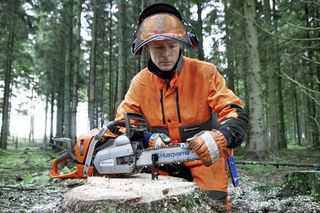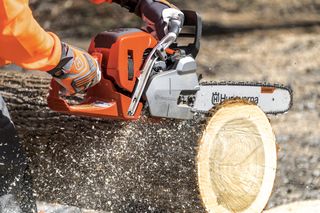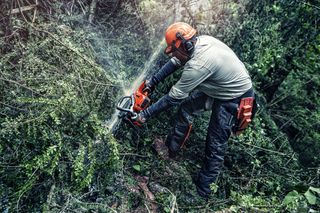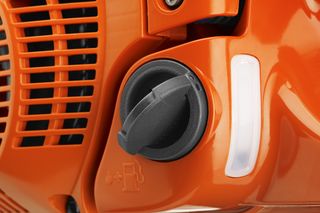
How to Cut Firewood
There is an old saying that cutting your own firewood should keep you warm twice. The first time when you are cutting the wood and the second time when you are burning it. However, that doesn't need to be the case and once you know how to properly cut firewood, things become less strenuous. Understanding the type of wood, whether it is new or old, in what way the grain goes and so much more plays a pivotal role in properly cutting firewood.
Best equipment for cutting firewood
Traditionally, wood saws were commonly used for cutting firewood. But wood saws require a lot of manual effort to get the teeth of the saw to eat through the wood. Wood saws are the least popular option nowadays due to the amount of energy that needs to be exerted, especially when tackling particularly large logs.
The most popular option today is a quality chainsaw. They’re fast and efficient at cutting logs down into manageable firebox sized lengths. Selecting the appropriate chainsaw will depend on how much wood, and the size of the wood, you intend on cutting. A great example of a chainsaw for cutting firewood is the Husqvarna 440 E-series II chainsaw. The powerful 1.8-kilowatt power output and Smart Start operation make it a pleasure to use for any quantity of firewood cutting.

Once cut to size, a wood splitting axe is a great way to split larger blocks into wedges that will fit inside your firebox. Wood splitting axes are designed to split wood without becoming lodged within the timber fibres.
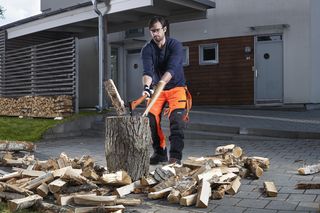
How to select the best tree for firewood
Understanding what type of trees make the best firewood is also important. Ideally, you will want a tree that is not only dry but consists of dense fibres that provide a long burn. This will reduce the amount of firewood that you need to cut. You’ll also benefit from burning clean, dry hardwood instead of any tree with a heavy resin or sap content. A wet or sap heavy tree may produce excess soot when burning, leading to a clogged chimney.
Finding trees that are able to regenerate themselves after being felled is also a great way to ensure that ecosystems are not disrupted.
The best trees for using as firewood in Australia include Two Veined Hickory, Cedar Wattle, Black She-Oak, Grey Gum, Brown Barrel, Prickly Paperbark, and Bracelet Honey Myrtle. Money Trees belonging to the eucalyptus family naturally coppice after they have been cut. This means that the trees will produce offshoots from the main stump that will turn into several trunks.

While it is true that every type of tree will burn, selecting a hardwood variety provides a more intense burn due to the density of the wood. Once you have selected an appropriate tree and have felled it, it will be time to cut it into firewood and allow it to dry for a period of 12 to 24 months.
Felling a tree for firewood
Once you have found a suitable tree that you want to use for firewood you should check it to ensure that it is not rotten. If you are cutting trees away from your property you should take into account the overall size and weight of the logs and branches.
The Husqvarna 572 XP® chainsaw is perfect for tackling small, medium and large-sized trees and can make quick work of the densest wood fibres. After you have felled your tree, cutting it into one metre long sections on the ground helps make turning it into firewood a much easier task.

How to cut firewood with a chainsaw
As soon as you have your tree ready to be turned into firewood you can make use of a sawhorse. A sawhorse is a piece of equipment that elevates the log off of the ground and prevents the chainsaw from hitting the dirt. It is recommended to cut branches and logs into easy to manage 1 metre long sections.
Place your 1 metre long pre-cut logs onto the sawhorse. Safety secure the log in place with a tie down strap to help keep it from moving while you are working on it.
Power up your chainsaw and position it on the first part of the log that you want to cut.
Cut the log into sections approximately 30cm long, or so they’ll fit in your firebox. For thicker logs, you can cut them along the middle to split them into 2 halves.

Place your freshly cut firewood in a dry location and allow it to dry properly. This may take up to two years. By splitting your firewood into smaller pieces it can dry out quicker. Using firewood that is damp or still contains moisture can create excess smoke and uses more heat to burn.
Staying safe
Cutting firewood can be extremely risky if you don't use appropriate PPE. Whether you are using a wood saw, a wood splitting axe or a chainsaw, face protection is always recommended. This can be in the form of protective eyewear.
For those using a chainsaw to cut firewood, ear protection can go a long way with preventing temporary tinnitus. Using long sleeve tops and trousers made from a thick fabric can help prevent any accidental cuts. Finally, a decent pair of protective saw gloves can help prevent blisters and splinters.

For those using a sawhorse. A decent pair of protective boots can help prevent any broken toes. It can be surprising just how heavy freshly cut wood can be. Many people also appreciate using a face mask or a neckerchief over the mouth and nose to prevent wood fibres from being inhaled.
Using your firewood
If you have cut down a deadwood tree or scavenged large branches from the ground to be used as firewood then these can typically be used within 2 to 3 months. However, if you have cut firewood from green wood trees then you are going to need to give it up to 24 months to properly dry out before using it.
Those looking to make the entire process a quick and simple one will appreciate the power offered by a chainsaw. This is especially true if you are tackling particularly thick tree trunks that are still living. A wood splitting axe is useful for smaller logs that are already dry and a manual wood saw is perfect for thin branches.
